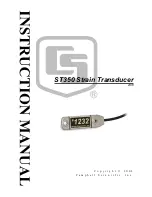
24
57-606 ECLIPSE Model 706 Guided Wave Radar Transmitter
Red (+)
Black (-)
(+)
(-)
2.5
Wiring
Caution:
HART versions of the ECLIPSE Model 706 transmitter
operate at voltages of 11–36 VDC, F
OUNDATION
fieldbus
versions operate at 9–17.5 VDC, and Modbus versions
operate at 8–30 VDC. Higher voltages will damage the
transmitter.
Wiring connections between the power supply and the
ECLIPSE Model 706 transmitter should be made using
18–22 AWG shielded twisted pair instrument cable.
Connections are made to the terminal strip and the
ground connections within the top enclosure compartment.
The directions for wiring the ECLIPSE transmitter depend
on the application:
• General Purpose or Non-Incendive (Cl I, Div. 2)
• Intrinsically Safe
• Explosion Proof
WARNING!
Explosion hazard. Do not disconnect equipment unless
power has been switched off or the area is known to be
non-hazardous.
2.5.1 General Purpose or Non-Incendive (Cl I, Div. 2)
A general purpose installation does not have flammable
media present.
Areas rated Non-Incendive (Cl I, Div. 2) have flammable
media present only under abnormal conditions.
No special electrical connections are required.
Caution:
If flammable media is contained in the vessel, the trans-
mitter must be installed per Class I, Div 1 standards of
area classification.
To install General Purpose or Non-Incendive wiring:
1. Remove the cover from the wiring compartment of the
transmitter. Install the conduit plug in the unused opening
and use PTFE tape/sealant to ensure a liquid-tight connec-
tion.
2. Install a conduit fitting and pull the supply wires.
3. Connect shield to an earth ground at power supply.
4. Connect an earth ground wire to the nearest green ground
screw (not shown in illustration).
5. Connect the positive supply wire to the (+) terminal and
the negative supply wire to the (-) terminal. (The recom-
mended torque on terminal block screws is 7–10 in-lbs.)
6. Replace and tighten the cover to the transmitter wiring
compartment before applying power.
Wiring Diagram
















































